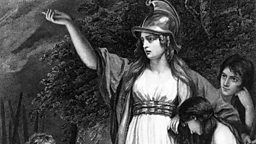Five powerful women in history you need to know about
Who runs the world? Girls! Well, Duchesses, Queens and Empresses…
This Women's History Month, why not dive into the funny history podcast You’re Dead to Me with host Greg Jenner to meet five powerful women who left their mark on the world forever?

Emperor Wu

Back in Medieval China, Emperor Wu was the daughter of a lumber merchant and the only woman ever to rule China in her own right. At first, she ruled as regent for her sickly and boring husband, and after his death exiled her eldest son so she could rule on behalf of her second (more malleable) son Ruizong. Eventually, she exiled Ruizong as well – making herself Emperor Wu in 690AD. Although she is sometimes referred to as Empress Wu, she was really Emperor Wu, as at the height of her power she didn’t rely on a husband to rule.
Wu was a shrewd, intelligent and at times ruthless leader. At least, that’s what we’re told by the (male) historians who recorded her life and reign. She quashed rebellions, successfully fended off Turkish and Tibetan invasions with diplomacy (and bribery) and had a good eye for admin.
Wu was deposed in 705AD by rivals from the previous Tang dynasty and died shortly after at the age of 81.
Hear more about Wu in the podcast.
Empress Theodora
The tale of Theodora’s rise to power is perhaps one of the most underrated rags-to-riches stories in history. She was the daughter of a bear trainer and made a living as an actress and (very likely) a sex worker before catching the eye of the soon-to-be Emperor Justinian I of the Byzantine Empire.
We can’t be sure how they met, but most historians agree that they met at the Hippodrome (a sporting and social hub – the Byzantine Empire’s equivalent of your local leisure centre) in Constantinople, and when he later became Emperor he ruled closely with Theodora. Under Justinian’s reign, likely with influence or even leadership by Theodora, laws were put in place to improve the lives of women. Punishments for rapists were made more severe and facilities were established to protect sex workers.
Upon her death, Justinian called her “Our most pious consort given us by God”, and he wasn’t the only one convinced of her calibre – today, both Justinian and Theodora are saints in the Eastern Orthodox Church. #HumbledAndBlessed.
Hear about Justinian and Theodora in the podcast.
Agrippina the Younger

Simply put, Agrippina the Younger was one of the most powerful women in the Ancient World. She exerted unprecedented power and influence in the reigns of no less than three Roman emperors – she was the sister of the emperor Caligula, the wife of Claudius and the mother of Nero.
She was so powerful that her son, Nero, tried to kill her several times. He also failed several times, partly because so many would-be-assassins were too afraid to try and kill her. After all, as the granddaughter of Augustus, she was believed to have the blood of a god coursing through her veins. She had no such fears about knocking off people who got in her way – it is likely she tried to kill her husband with a poisonous mushroom. Tasty.
As if her CV isn’t impressive enough, the city of Cologne, originally called Colonia Claudia Ara Agrippinensiu, was named in her honour as the place of her birth and she was the first Roman woman to appear alongside the Emperor on the front of a coin. Quids in!
Learn all about Agrippina in the podcast.
Boudica

You’ve probably heard of the fierce, flame-haired Celtic warrior queen Boudica. And at least two of those things are probably true. Boudica, whose name means “victory”, was (kind of) Queen of the British Celtic Iceni tribe and led a revolt against the Roman Empire in AD 60 or 61.
After Boudica was stripped, thrashed, and her daughters brutally violated by the Romans in a cruel show of power, Boudica burned the city of Colchester to the ground. At the time, this was the biggest Roman settlement in the area and a place where they had just built a temple to the former emperor (and now god) Claudius.
She was a woman who went toe-to-toe with the exceptionally powerful Roman Empire and very nearly won.
It is estimated that 70,000–80,000 people of all ages and genders, both Roman and British, were killed in Boudica’s wake. Her conquest was so effective that Nero, the awful son of Agrippina the Younger, considered withdrawing all Roman forces from Britain.
More of a problematic fave than a feminist icon, Boudica killed a lot of people. She was a woman who went toe-to-toe with the exceptionally powerful Roman Empire and very nearly won. But we don’t know what colour her hair was. Sorry!
Join Greg Jenner and Sarah Pascoe to learn about Boudica.
Eleanor of Aquitaine
A true matriarch of the Middle Ages, Eleanor of Aquitaine was Queen of France (as the wife of Louis VII) and later Queen of England (after getting hitched to Henry II). But her power and status wasn’t only due to her husbands. Even before her first marriage, she was Duchess of Aquitaine and one of the wealthiest women in Western Europe.
She accompanied Louis VII during the Second Crusade where she survived an ambush by Seljuk Turks during a royal visit to see the Emperor of Byzantine. Worse than a surprise attack in the mountains, she had to stomach getting sex tips from Pope Eugenius III. Cringe.
Eleanor gave birth to at least ten children, three of whom went on to be Kings (Henry the Young King, Richard I and John) and two Queens (Eleanor of England and Matilda of England). And they never gave her a moment’s peace. Eleanor was imprisoned for 15 years by her husband, Henry II, for supposedly aiding her sons in a rebellion against him, and at the age of 80 led the defence of a castle during an uprising against her grandson Arthur of Brittany. Her astonishing life came to an end in 1204.
Learn about Eleanor of Aquitaine alongside Rachel Parris and Greg Jenner.

Eleanor of Aquitaine from the Radio 4 series Eleanor Rising



































